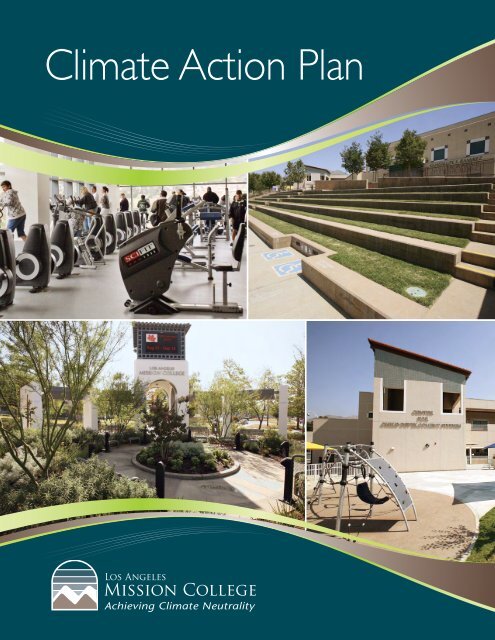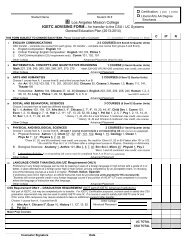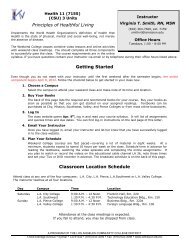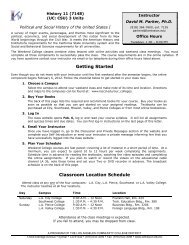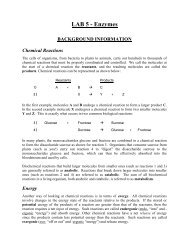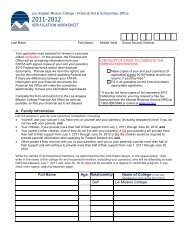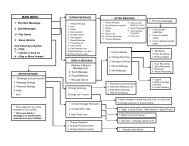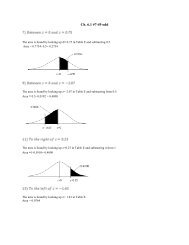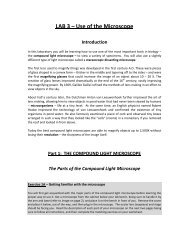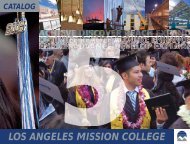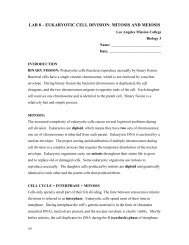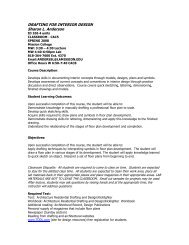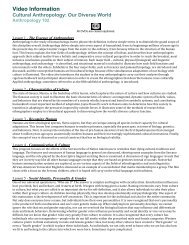Download PDF Version - Los Angeles Mission College
Download PDF Version - Los Angeles Mission College
Download PDF Version - Los Angeles Mission College
Create successful ePaper yourself
Turn your PDF publications into a flip-book with our unique Google optimized e-Paper software.
Climate Action Plan
Acknowledgements<br />
LOS ANGELES COMMUNITY COLLEGE DISTRICT<br />
BOARD OF TRUSTEES<br />
Georgia L. Mercer, President<br />
Miguel Santiago, First Vice President<br />
Nancy Pearlman, Second Vice President<br />
Kelly Candaele<br />
Mona Field<br />
Tina Park<br />
Sylvia Scott-Hayes<br />
Linda L. Tong, Student Trustee<br />
Chancellor<br />
Daniel LaVista, Ph.D.<br />
LOS ANGELES MISSION COLLEGE<br />
President<br />
Judith Valles
Contents<br />
LETTER FROM THE PRESIDENT . . . . . . . . . . . . . . . . . . . . . . . . . . . . . . . . . . . . . .2<br />
Introduction . . . . . . . . . . . . . . . . . . . . . . . . . . . . . . . . . . . . . . . . . . . . . . . . . . . . . . .3<br />
Climate Change Affects the World, Our Nation, and Our<br />
Communities… and, We Effect Climate Change . . . . . . . . . . . . . . . . . . . . . . . . . .5<br />
New Lessons in Higher Education . . . . . . . . . . . . . . . . . . . . . . . . . . . . . . . . .6<br />
<strong>Los</strong> <strong>Angeles</strong> Community <strong>College</strong> District . . . . . . . . . . . . . . . . . . . . . . . . . . .7<br />
Doing Our Part at <strong>Mission</strong> <strong>College</strong> . . . . . . . . . . . . . . . . . . . . . . . . . . . . . . . .9<br />
Our Course for a Climate Action Plan . . . . . . . . . . . . . . . . . . . . . . . . . . . .10<br />
Building a Baseline Greenhouse Gas Inventory . . . . . . . . . . . . . . . . . . . . . . . . . .12<br />
Emissions Forecast and Achieving Climate Neutrality . . . . . . . . . . . . . . . . . . . . .16<br />
Climate Action Strategies . . . . . . . . . . . . . . . . . . . . . . . . . . . . . . . . . . . . . . . . . . .18<br />
Buildings . . . . . . . . . . . . . . . . . . . . . . . . . . . . . . . . . . . . . . . . . . . . . . . . . . . .18<br />
Renewable Energy . . . . . . . . . . . . . . . . . . . . . . . . . . . . . . . . . . . . . . . . . . . . .23<br />
Transportation . . . . . . . . . . . . . . . . . . . . . . . . . . . . . . . . . . . . . . . . . . . . . . .24<br />
Operations . . . . . . . . . . . . . . . . . . . . . . . . . . . . . . . . . . . . . . . . . . . . . . . . . .26<br />
Education, Community Outreach, and Research . . . . . . . . . . . . . . . . . . . . .26<br />
Monitoring and Tracking Progress . . . . . . . . . . . . . . . . . . . . . . . . . . . . . . . . . . . . .28<br />
Work with Us on Our Climate Action Plan . . . . . . . . . . . . . . . . . . . . . . . . . . . . .28<br />
i
LETTER FROM THE PRESIDENT<br />
Dear friends of <strong>Los</strong> <strong>Angeles</strong> <strong>Mission</strong> <strong>College</strong>,<br />
Over the past decade, <strong>Los</strong> <strong>Angeles</strong> <strong>Mission</strong><br />
<strong>College</strong> has taken important steps to be a<br />
more sustainable institution. We have adopted<br />
sustainable building practices in which all new<br />
buildings will be certified green buildings.<br />
We have implemented measures to reduce<br />
our water and energy use, and the amount<br />
of waste that we send to landfills. We offer<br />
programs to encourage use of our public<br />
transportation system. We have also begun<br />
collecting and reporting our annual greenhouse<br />
gas emissions to help understand<br />
our environmental footprint better. Now, our focus is on achieving aggressive<br />
greenhouse gas reduction goals.<br />
Climate change is a significant challenge that we face, and we must act now to<br />
avoid the most life-altering effects. In 2007, to strengthen our commitment to<br />
sustainability, <strong>Los</strong> <strong>Angeles</strong> <strong>Mission</strong> <strong>College</strong> signed the American <strong>College</strong> and<br />
University President’s Climate Commitment, and joined hundreds of other<br />
colleges and universities across the country that have committed to becoming<br />
a climate-neutral campus.<br />
<strong>College</strong>s may not be large greenhouse gas emitters on the global scale, but our<br />
influence is large, and it is important that we provide a good example not only<br />
for our students, but also for our community. <strong>Mission</strong> <strong>College</strong> educates more<br />
than 9,000 students every year from our local community and that number is<br />
expected to grow. We have the opportunity to transform lives, and we recognize<br />
that sustainability must be part of that transformation.<br />
<strong>Mission</strong> <strong>College</strong> has taken the bold step of developing and putting into action a<br />
plan that will help us reduce our greenhouse gas emissions. Now, we are pleased<br />
to present our climate action plan here. Through continued collaboration on implementing<br />
our climate action plan, we can achieve our goals of climate neutrality.<br />
Judith Valles<br />
President, <strong>Mission</strong> <strong>College</strong><br />
2
INTRODUCTION<br />
<strong>Los</strong> <strong>Angeles</strong> <strong>Mission</strong> <strong>College</strong> is on a quest to become climate neutral by 2050<br />
We’re serious about this quest: we made an official commitment to it by agreeing<br />
to the American <strong>College</strong> and University President’s Climate Commitment in 2007.<br />
How do we get there?<br />
<strong>Los</strong> <strong>Angeles</strong> <strong>Mission</strong> <strong>College</strong> (<strong>Mission</strong> <strong>College</strong>) has taken the initial steps. We have<br />
developed our baseline greenhouse gas inventory, determined our strategies, and<br />
begun to implement measures. Now, our climate action plan will guide us toward<br />
achieving greenhouse gas emission reductions and climate neutrality. This critical<br />
tool is a roadmap into our future. It will help us monitor progress, measure outcomes,<br />
and be accountable.<br />
Our climate action plan outlines strategies and milestones to lead <strong>Mission</strong> <strong>College</strong><br />
students, faculty, and staff through the next 40 years. This is a crucial time period<br />
during which our actions, along with those of institutions, businesses, and governments<br />
around the world, will largely determine the world’s fate with global warming.<br />
As our climate action plan progresses, we have many responsibilities:<br />
■ We have to dedicate our efforts to short-, medium-, and long-term tasks.<br />
■<br />
■<br />
■<br />
■<br />
We have to learn new thought processes, knowledge fields, techniques, and<br />
cutting-edge technologies to apply new processes and introduce new solutions.<br />
We also have to embrace lessons from unintended or unexpected results.<br />
We have to be resourceful and collaborative. We have to acquire skills and<br />
knowledge from institutions experienced in certain project areas, and we<br />
have to share best practices and experiences with institutions tackling new<br />
challenges, in which we have gained insights.<br />
We have to be adaptable to changes for a better future, be patient<br />
through processes, and be flexible in adjusting our course when called<br />
for by external factors.<br />
We have to recognize the small wins and the major accomplishments.<br />
Most importantly, for our climate action plan to succeed, we must ensure<br />
two conditions are consistently met:<br />
■ Everyone at <strong>Mission</strong> <strong>College</strong> must be involved: students, faculty, administrators,<br />
and staff. We hope everyone will be actively engaged as we execute<br />
our plan and work together towards an environmentally and economically<br />
sustainable future for all.<br />
■<br />
Climate action plan strategies and tactics must align with our vision:<br />
to be an exemplary model for student academic, technological and<br />
artistic achievement.<br />
3
CLIMATE CHANGE<br />
IMPACTS OUR<br />
WORLD, OUR<br />
NATION AND<br />
OUR COMMUNITY
Climate Change Affects the World, Our<br />
Nation, and Our Communities…and,<br />
We Effect Climate Change<br />
Climate change presents one of the most<br />
profound challenges of our time. A broad<br />
international consensus exists among atmospheric<br />
scientists that Earth’s climate system<br />
is changing in response to elevated levels of<br />
greenhouse gas emissions in the atmosphere<br />
primarily from the combustion of fossil fuels<br />
for energy use.<br />
Global Climate Change Impacts in the<br />
United States 1 —a few key findings:<br />
1. Global warming is unequivocal and<br />
primarily human-induced.<br />
Average global temperature has increased<br />
over the past 50 years. This observed increase<br />
is primarily due to human-induced<br />
emissions of heat-trapping gases.<br />
2. Climate changes are underway in the<br />
United States and are projected to grow.<br />
Climate-related changes have already<br />
been observed in the United States and its<br />
coastal waters. These include increases in<br />
heavy downpours, rising temperature<br />
and sea level, rapidly retreating glaciers,<br />
thawing permafrost, lengthening growing<br />
seasons, lengthening ice-free seasons in<br />
the ocean and on lakes and rivers, earlier<br />
snowmelt, and alterations in river flows.<br />
These changes are projected to grow.<br />
3. Widespread climate-related impacts<br />
are now occurring and are expected<br />
to increase.<br />
Climate change is already affecting water,<br />
energy, transportation, agriculture, ecosystems,<br />
and health. These impacts are<br />
different from region to region and will<br />
grow under projected climate change<br />
scenarios.<br />
4. Future climate change and its impacts<br />
depend on choices made today.<br />
The amount and rate of future climate<br />
change depend primarily on current and<br />
future human-caused emissions of heattrapping<br />
gases and airborne particles.<br />
Responses involve reducing emissions<br />
to limit future warming, and adapting<br />
to the changes that are unavoidable.<br />
We need to reduce greenhouse<br />
gas emissions: 2,3<br />
■<br />
■<br />
■<br />
Over the next century, limiting the increase<br />
in average global temperature to 2°C<br />
may avoid the most damaging and<br />
irreversible impacts of global warming.<br />
Greenhouse gas emissions need to be<br />
stabilized well below 450 parts per million<br />
to minimize the average global temperature<br />
increase to 2°C.<br />
Global greenhouse gas emissions must<br />
be reduced by at least 50% of their<br />
1990 levels by the year 2050, in order to<br />
reduce the risks of severe climate change.<br />
1. U.S. Global Change Research Program (USGCRP) 2009. “Global Climate Change Impacts in the United States.” Page 12.<br />
http://www.globalchange.gov/publications/reports/scientific-assessments/us-impacts This report was issued in 2009, by a task force of<br />
U.S. government science agencies led by the National Oceanic and Atmospheric Administration (NOAA).<br />
2. International Climate Change Task force. “Meeting the Challenge of Climate Change.” 2005. http://www.americanprogress.org/kf/climatechallenge.pdf<br />
3. University of New South Wales Climate Change Research Centre. http://www.ccrc.unsw.edu.au/news/2007/Bali.html 2007 Bali Declaration by Scientists.<br />
5
New Lessons in Higher Education<br />
We have all contributed to the progression<br />
of climate change, and we all have a role<br />
in changing its course.<br />
<strong>College</strong>s and universities have a pivotal role<br />
in advancing sustainable business practices,<br />
since we have a great influence on our next<br />
generation of young professionals. We have<br />
a responsibility to lead our students on the<br />
right course, through learning opportunities<br />
that empower them to understand climate<br />
change, make decisions for sustainable<br />
living, and use new skills to build a safer<br />
and healthier future.<br />
Higher education is a billion dollar economic<br />
engine: We employ millions of people;<br />
consume vast resources, manufactured<br />
goods, and services; and cater to more than<br />
17 million students who are attending the<br />
more than 4,000 higher learning institutions<br />
in the United States. 4 Students will pursue<br />
many different careers, and they will have<br />
an impact on businesses, organizations, and<br />
operations of all types. They need to acquire<br />
knowledge and skills in new disciplines to<br />
effect positive change.<br />
Higher education is in the best position<br />
to not only teach our next generations<br />
the critical lessons and tools to create<br />
a new course for our future, but also to<br />
take actions as an institution to model<br />
ways that can help foster improved<br />
climate conditions.<br />
The American <strong>College</strong> & University Presidents’ Climate Commitment (ACUPCC)<br />
is a growing network of colleges and universities that have committed to develop<br />
and implement plans in pursuit of climate neutrality. 5<br />
Higher education has been granted tax-free status, the ability to receive public and<br />
private funds, and academic freedom, in exchange for educating students and producing<br />
the knowledge that will result in a thriving civil society. For these reasons,<br />
higher education has a moral and social responsibility to rise to this challenge. 6<br />
American <strong>College</strong> & University Presidents’ Climate Commitment.<br />
4. ACUPCC Website “Why Sign the Commitment” http://www.presidentsclimatecommitment.org/about/commitment/why-sign<br />
5. ACUPCC Website “<strong>Mission</strong> and History” http://www.presidentsclimatecommitment.org/about/mission-history<br />
6. ACUPCC Website “Why Sign the Commitment” http://www.presidentsclimatecommitment.org/about/commitment/why-sign<br />
6
<strong>Los</strong> <strong>Angeles</strong> Community <strong>College</strong> District<br />
The <strong>Los</strong> <strong>Angeles</strong> Community <strong>College</strong> District<br />
(LACCD) is the largest community college<br />
district in the United States. It has nine<br />
colleges, including <strong>Mission</strong> <strong>College</strong>, and it<br />
covers an area greater than 882 square miles<br />
in more than 36 cities and communities.<br />
LACCD offers lifelong learning opportunities<br />
for students.<br />
As a higher education institutional system,<br />
LACCD recognized its responsibility to reduce<br />
greenhouse gas emissions. Former LACCD<br />
Chancellor Darroch Young and the current<br />
Chancellor Daniel LaVista also understood<br />
the urgency to take action. The District became<br />
one of the 12 founding signatories of<br />
the American <strong>College</strong> & University Presidents’<br />
Climate Commitment (ACUPCC) in 2006.<br />
LACCD has been a rising leader in advancing<br />
sustainable practices. Its hallmark initiative is<br />
the $6 billion Sustainable Building Program<br />
to replace buildings in states of disrepair<br />
and neglect.<br />
LACCD Firsts:<br />
■<br />
■<br />
■<br />
■<br />
■<br />
First community college system to require LEED certification for new buildings<br />
First community college system to achieve a BREEAM (BRE Environmental<br />
Assessment Method) certification<br />
First community college system to sign on to the ACUPCC Climate Commitment<br />
First community college system to host the UC/CSU/CCC Annual Sustainability<br />
Conference<br />
First community college system to join the California Climate Action Registry<br />
7
LACCD Awards and Recognitions<br />
2010<br />
IIDA Caliber Environmental Leadership Award for commitment to sustainability and<br />
influence on the broader community (International Interior Design Association)<br />
2009<br />
Sustainability Showcase Award, Other Products and Services category (California<br />
Sustainability Alliance)<br />
Community Impact Award (<strong>Los</strong> <strong>Angeles</strong> Business Council)<br />
Higher Education Energy Efficiency Best Practices award (UC/CSU/CCC Sustainability<br />
Conference)<br />
Green California Leadership Award (Green Technology and Advisory Board for the<br />
Green Calif. Summit)<br />
Sustainable Leadership and Design Development Non-Profit award (CoreNet Global)<br />
Leonardo Public Sector Industry Honor Award (Society for Marketing Professional<br />
Services, <strong>Los</strong> <strong>Angeles</strong> Chapter)<br />
2008<br />
Green Leadership Achievement Award (Green California Community <strong>College</strong> Summit)<br />
REmmy Corporate Citizens Award (CoreNet Global)<br />
Energy Efficiency Partnership Program Best Practices in New Construction &<br />
Sustainable Operations (UC/CSU/CCC Sustainability Conference)<br />
2007<br />
Clinton Climate Initiative<br />
Governor's Environmental and Economic Leadership Award - Sustainable Practices<br />
or Facilities<br />
California Construction Owner of the Year - McGraw Hill (California Construction<br />
Magazine)<br />
2006<br />
Savings by Design Award (Southern California Gas Company)<br />
Sustainable Future Award (U.S. Green Building Council - <strong>Los</strong> <strong>Angeles</strong> Chapter)<br />
Flex Your Power (State of California)<br />
2005<br />
Flex Your Power Education and Leadership (State of California)<br />
Visionary Leadership Award (U.S. Green Building Council - <strong>Los</strong> <strong>Angeles</strong> Chapter)<br />
Sempra Energy Efficiency Excellence Award<br />
2004<br />
California/Local Environmental Leadership Award (Global Green U.S.A.<br />
Millennium Awards)<br />
Visionary Award (U.S. Green Building Council)<br />
Flex Your Power Award (State of California)<br />
8
Doing Our Part at <strong>Mission</strong> <strong>College</strong><br />
Founded in 1975, <strong>Mission</strong> <strong>College</strong> is the<br />
youngest of the nine colleges in the <strong>Los</strong><br />
<strong>Angeles</strong> Community <strong>College</strong> District. We<br />
offer accessible, affordable and high quality<br />
education in a culturally and intellectually<br />
supportive environment across our 32 acre<br />
campus in Sylmar, California.<br />
Our campus is undergoing a<br />
transformation.<br />
Student enrollment is expected to continue<br />
to increase through 2015 to near 15,000<br />
students from our current 11,500 students.<br />
To accommodate this growth we will be<br />
expanding to a total of 555,000 square feet<br />
of instructional and support facilities on the<br />
Main Campus and our new East Campus.<br />
We are dedicated to<br />
creating a more<br />
sustainable future.<br />
1<br />
3<br />
4<br />
2<br />
9<br />
HUBBARD STREET<br />
5 6 7 8<br />
bk<br />
bl<br />
bm<br />
MAIN CAMPUS<br />
1 CHILD DEVELOPMENT CENTER<br />
2 COLLABORATIVE STUDIES<br />
3 CAMPUS SERVICES<br />
4 FAMILY & CONSUMER STUDIES/BOOKSTORE<br />
ELDRIDGE AVENUE<br />
5 LEARNING RESOURCE CENTER/LIBRARY<br />
6 MAIN QUAD<br />
7 CAMPUS CENTER<br />
8 MEDIA ARTS<br />
9 PLANT FACILITIES & CENTRAL PLANT<br />
bk PARKING STRUCTURE<br />
bl INSTRUCTIONAL ADMINISTRATION<br />
bm STUDENT SERVICES & ADMINISTRATION<br />
MACLAY STREET<br />
br<br />
bq<br />
bn<br />
bo<br />
bp<br />
HARDING STREET<br />
EAST CAMPUS<br />
bn PROPOSED NCAA SOCCER FIELD<br />
bo PROPOSED NCAA SOFTBALL FIELD<br />
bp PROPOSED NCAA BASEBALL FIELD<br />
bq HEALTH FITNESS & ATHLETIC COMPLEX<br />
br EAST CAMPUS BUILDING<br />
9
Our Course for a Climate Action Plan<br />
From our buildings and curriculum to our administration and operations, we are making<br />
physical, environmental, and social changes to improve <strong>Mission</strong> <strong>College</strong> to meet the needs<br />
of our students.<br />
Cultivating campus sustainability is a cornerstone of the <strong>Mission</strong> <strong>College</strong> climate<br />
action plan.<br />
As a signatory of the American <strong>College</strong> & University Presidents’ Climate Commitment,<br />
<strong>Mission</strong> <strong>College</strong> agreed to:<br />
■<br />
■<br />
■<br />
■<br />
■<br />
Complete a greenhouse gas emissions inventory<br />
Set a target date for becoming climate neutral<br />
Take immediate steps to reduce greenhouse gas emissions<br />
Integrate sustainability into the curriculum and make it part of the educational<br />
experience<br />
Develop a climate action plan that outlines strategies and tactics to achieve<br />
climate neutrality<br />
Here, in our climate action plan, we highlight strategies and tactics that will enable us to<br />
minimize greenhouse gas emissions and meet our social mandate to help create a thriving,<br />
ethical and sustainable society.<br />
10
ESTABLISHING<br />
A BASELINE
Building a Baseline Greenhouse<br />
Gas Inventory<br />
In 2005, as part of an LACCD district-wide<br />
initiative, <strong>Mission</strong> <strong>College</strong> joined the California<br />
Climate Action Registry (CCAR). That year,<br />
LACCD conducted a greenhouse gas (GHG)<br />
emissions inventory of the 2004 calendar<br />
year to establish a baseline for each of its<br />
nine campuses and the District Office. LACCD<br />
has conducted subsequent inventories for<br />
2005 through 2009.<br />
<strong>Mission</strong> <strong>College</strong>’s greenhouse gas inventory<br />
accounts for emissions in three categories:<br />
■<br />
■<br />
■<br />
Consumption of natural gas in campus<br />
buildings and other onsite combustibles,<br />
such as gasoline-driven lawn mowers<br />
and diesel back-up generators<br />
Electricity consumption in campus<br />
buildings<br />
Gasoline and diesel fuel consumption for<br />
student, faculty and staff commuting<br />
The Kyoto Protocol is a protocol<br />
to the United Nations Framework<br />
Convention on Climate Change<br />
(UNFCCC). The agreement identifies<br />
six high priority greenhouse gases<br />
for reductions:<br />
■<br />
■<br />
■<br />
■<br />
■<br />
■<br />
Carbon dioxide (CO2)<br />
Methane (CH4)<br />
Nitrous Oxide (N2O)<br />
Hydroflourocarbons (HFCs)<br />
Perflourocarbons (PFCs)<br />
Sulfur hexafluoride (SF6)<br />
Climate Leader Recognized by California Climate Action Registry (CCAR)<br />
<strong>Mission</strong> <strong>College</strong> follows the CCAR General Reporting Protocol<br />
to collect, calculate, and report GHG emissions data.<br />
<strong>Mission</strong> <strong>College</strong>’s 2007, 2008 and 2009 inventories have<br />
been adjusted to include all six greenhouse gases.<br />
A third party verifies all of <strong>Mission</strong> <strong>College</strong>’s data collected.<br />
<strong>Mission</strong> <strong>College</strong>’s annual emission reports are available to the public on the California<br />
Climate Action Registry (CCAR) website, www.climateregistry.org/.<br />
12
Since we began measuring and monitoring<br />
our GHG emissions, <strong>Mission</strong> <strong>College</strong> has<br />
undergone numerous facility changes, which<br />
include a new parking structure; the new<br />
Bio Lab; new Health, Fitness, and Athletic<br />
Complex; and the nearly completed Family<br />
and Consumer Studies Building. The new<br />
facilities will better serve our students. With<br />
this growth however, comes an increase in<br />
campus emissions.<br />
■<br />
■<br />
■<br />
The largest increase in emissions comes<br />
from electricity use in buildings.<br />
Emissions from natural gas used for<br />
boilers and kitchen equipment have<br />
remained relatively constant.<br />
Emissions from commuting and air travel<br />
have also remained relatively stable, but<br />
are estimated to rise as the student population<br />
is projected to increase.<br />
13
Building Electricity<br />
<strong>Mission</strong> <strong>College</strong> campus buildings typically<br />
use electricity for lighting, motors, fans,<br />
heating and cooling systems, and plug loads,<br />
such as computers. We purchase electricity<br />
from the <strong>Los</strong> <strong>Angeles</strong> Department of Water<br />
and Power.<br />
We purchased 5,349 megawatt-hours<br />
(MWh) of electricity from <strong>Los</strong> <strong>Angeles</strong><br />
Department of Water and Power in<br />
2008, equivalent to 2,984 MTCO2e.<br />
Transportation Fuels<br />
Commuting is part of everyday life at a<br />
community college, for faculty, staff, and<br />
students, alike. In 2008, <strong>Mission</strong> <strong>College</strong><br />
student, staff, and faculty commuters<br />
were responsible for approximately 2,535<br />
MTCO2e of indirect mobile (gasoline and<br />
diesel) emissions.<br />
Building Natural Gas<br />
As of 2008, the main sources of natural<br />
gas consumption are boilers and kitchen<br />
equipment. 7 The Southern California Gas<br />
Company supplies this natural gas.<br />
We purchased 82,548 therms of natural<br />
gas from Southern California Gas<br />
Company, equivalent to 439 MTCO2e.<br />
What is a metric ton of carbon dioxide equivalent (MTCO2e)?<br />
Each of the six Kyoto greenhouse gases has different global warming potentials, meaning<br />
they have differing abilities to trap heat in the atmosphere. The total emissions of all six<br />
greenhouse gases are normalized according to their global warming equivalence to a<br />
molecule of carbon dioxide (CO2e). And a metric ton is approximately 2204 pounds!<br />
7. <strong>Los</strong> <strong>Angeles</strong> Community <strong>College</strong> District, Greenhouse Gas Emissions Inventory Verification Report, 2008, Appendix D<br />
14
ACHIEVING<br />
CLIMATE<br />
NEUTRALITY
Emissions Forecast and Achieving<br />
Climate Neutrality<br />
Global greenhouse gas emissions must be<br />
reduced 50-80% by 2050 to avoid dramatic<br />
consequences of climate change. 8<br />
California has committed to reduce<br />
GHG emissions by 80% of its 1990<br />
levels, by 2050. 9<br />
<strong>Mission</strong> <strong>College</strong> will go beyond the recommended<br />
reduction goal for GHG emissions<br />
to achieve climate neutrality by 2050.<br />
A climate action plan must state an emissions<br />
forecast. This forecast helps foster a concerted<br />
effort to implement emission reduction<br />
projects, and it establishes a comparative<br />
measure between future emission reductions<br />
and business-as-usual (BAU) emission levels<br />
to track progress.<br />
The business-as-usual emissions forecast for<br />
<strong>Mission</strong> <strong>College</strong> is based on several factors:<br />
■<br />
The emissions trend calculated from<br />
2004 through 2009<br />
■<br />
■<br />
The new construction projects planned<br />
through 2015<br />
A projected trend line for <strong>Mission</strong><br />
<strong>College</strong>’s emissions from continued<br />
expansion on our Main Campus, East<br />
Campus and Athletic Fields Complex<br />
In this climate action plan, we share how we<br />
will move away from the business-as-usual<br />
scenario and achieve climate neutrality.<br />
What is Climate Neutrality?<br />
According to the ACUPCC, climate<br />
neutrality is defined as having no net<br />
greenhouse gas emissions.<br />
Climate neutrality can be achieved by<br />
minimizing GHG emissions as much as<br />
possible, prior to considering carbon<br />
offsets or other offsite mitigation<br />
measures.<br />
16<br />
8. Intergovernmental Panel on Climate Change – Fourth Assessment Report (2007).<br />
9. Executive Order S-3-05, signed by Governor Schwarzenegger in 2005
IMPROVING<br />
CAMPUS<br />
LIFE
Climate Action Strategies<br />
<strong>Mission</strong> <strong>College</strong>’s climate action strategies target the largest sources of greenhouse<br />
gas emissions: buildings and transportation.<br />
Buildings<br />
DISTRICT-WIDE SUSTAINABLE BUILDING PROGRAM<br />
In 2002, the <strong>Los</strong> <strong>Angeles</strong> Community <strong>College</strong> District Board of Trustees adopted<br />
a groundbreaking commitment to sustainability — a sustainable policy mandate<br />
that requires a LEED-certified rating or better for all new construction and major<br />
renovation projects throughout its college campuses. Today, the LACCD is at<br />
the helm of a $6 billion Sustainable Building Program, which is among the<br />
nation’s largest environmentally friendly green-building programs.<br />
The Sustainable Building Program cultivates positive impacts for society:<br />
■<br />
■<br />
■<br />
Creates improved environments that are better suited to prepare and<br />
train students for twenty-first century jobs<br />
Boosts the California economy<br />
Models sustainable practices and decreases the District’s GHG emissions<br />
To supplement the Board’s policy, a sustainable standards and specification was<br />
launched to give designers guidelines to focus their efforts on conserving energy,<br />
integrating sustainable siting design, reducing waste and water consumption,<br />
improving indoor air quality, and using sustainable materials and resources.<br />
All buildings will be designed and constructed with environmental<br />
sensitivity in mind.<br />
18
LACCD Building Measures to Reduce Greenhouse<br />
Gas Emissions and Improve Campus Sustainability<br />
Water use measures<br />
■<br />
■<br />
■<br />
■<br />
Collect all stormwater so none shall leave<br />
the campus: store collected stormwater<br />
to re-use or infiltrate onsite<br />
Reduce potable water demand for all<br />
landscaping by a minimum of 50%:<br />
utilize Xeriscaping and drought<br />
resistant planting<br />
Reuse and collect greywater<br />
Reduce potable water demand for<br />
buildings by at least 40%: install<br />
waterless urinals in all new and<br />
existing buildings<br />
Energy use measures<br />
■ Reduce the heat island effect: use cool<br />
roofs and appropriate materials, such as<br />
green roofs where applicable and less<br />
dark materials like asphalt<br />
■ Design new buildings to exceed Title 24<br />
by 20% and major renovations to exceed<br />
Title 24 by 10%<br />
■ Measure and verify energy use and analyze<br />
system trends to optimize building<br />
operations and energy performance<br />
■<br />
Conduct whole-building enhanced<br />
commissioning to ensure systems are<br />
operating as designed and maximize<br />
energy efficiency<br />
Renewable energy generation<br />
measures<br />
■<br />
■<br />
Use photoluminescent exit signage,<br />
which harnesses solar power, thereby<br />
reducing electricity demand from<br />
electric-powered exit signs<br />
Generate at least 10% of each building’s<br />
energy through renewable technologies<br />
What is Title 24?<br />
Title 24 of the California Code of<br />
Regulations, also known as the<br />
California Building Standards Code,<br />
contains the regulations that govern<br />
the energy consumption standards<br />
for buildings.<br />
19
Material reuse and recycling measures<br />
■<br />
■<br />
■<br />
Ensure 90% of materials generated from<br />
construction and demolition activities are<br />
diverted from landfills: recycle, reuse, or<br />
repurpose a minimum of 90% marketable<br />
materials. (LACCD’s goal is to divert<br />
100% of all construction and demolition<br />
waste from landfills.)<br />
Use recycled carpet that comprises<br />
100% recycled content for the backing<br />
and up to 75% recycled content for the<br />
carpet fiber.<br />
Use 35% fly ash in concrete, which<br />
contributes to recycled content use.<br />
<strong>Mission</strong> <strong>College</strong> will continue to undergo<br />
facility renovations and new construction.<br />
While new buildings contribute to a net<br />
increase in electricity and natural gas<br />
consumption, we are seeking to reduce<br />
the impact as much as possible through<br />
implementing LEED standards for new<br />
construction.<br />
<strong>Mission</strong> currently has seven LEED projects<br />
registered, with a range of targets from<br />
Certified to Platinum levels.<br />
Sustainable carpet materials: Every fiber counts<br />
LACCD’s carpet manufacturer has agreed to reduce the cost, demonstrate the ability to<br />
recycle products at the end of their useful lives, and adhere to other sustainable practices:<br />
■<br />
■<br />
■<br />
■<br />
■<br />
Use materials in which a minimum of 90% can be recycled<br />
Obtain third-party certification to verify antimicrobials have not been added<br />
to products<br />
Obtain third-party certification for the use of environmentally preferable products<br />
Use only products that comply with the U.S. Federal Trade Commission’s<br />
guidelines to environmental marketing for recycled content<br />
Offer a take-back program in place for its products, with a sustainable warranty<br />
that guarantees all carpet returned will be recycled in its entirety and no portion<br />
will be added to a landfill, incinerated (including waste-to-energy), or disposed<br />
of in any other way<br />
20
Child Development Center<br />
We built the new Child Development Center<br />
to serve as an ideal child development laboratory<br />
for students majoring in Childhood<br />
Education. Students use the facility to identify,<br />
study, and demonstrate developmentally<br />
appropriate practices for childhood development.<br />
It also offers a high quality childhood<br />
education and care program for the college<br />
community as well as the local community<br />
at-large. The facility includes classrooms,<br />
three observation rooms for parents, students<br />
and faculty, a staff room, an open office area,<br />
outdoor age-appropriate play areas, and<br />
warming kitchen for receiving and<br />
distributing meals.<br />
The facility is designed to be LEED Certified.<br />
We incorporated a variety of sustainability<br />
features in the design of the building including:<br />
■<br />
■<br />
■<br />
Building materials that are high in<br />
recycled content<br />
Drought resistant and native plants to<br />
reduce irrigation needs<br />
A roof designed to accommodate future<br />
photovoltaic cells<br />
■<br />
Extensive daylighting that creates a<br />
visually stimulating and productive<br />
environment<br />
21
Health, Fitness and Athletic Complex<br />
Completed in February 2010, our new Health,<br />
Fitness and Athletic Complex fulfilled a need<br />
that had been in existence for over 20 years.<br />
It replaced a rented warehouse one and a<br />
half miles from campus that held activities<br />
such as weight training and aerobics classes.<br />
The new athletic complex is an 89,500<br />
square-foot structure that comes with a<br />
3-court gym suitable for basketball and<br />
volleyball, as well as a fitness room,<br />
jogging track, five classrooms, a training<br />
room, locker rooms and offices.<br />
We designed the facility according to the<br />
U.S. Green Building Council’s LEED Silver<br />
rating standards. Green features include:<br />
■<br />
■<br />
■<br />
■<br />
■<br />
Locally sourced materials with high<br />
recycled content<br />
A “cool roof” to reduce cooling needs<br />
Water efficient low flow plumbing fixtures<br />
On-site thermal storage system<br />
Diversion of more than 90 percent of the<br />
construction waste from landfills<br />
Family and Consumer Studies Building<br />
Designed to achieve a LEED Platinum rating,<br />
the new Family and Consumer Studies Building<br />
will be a three-story learning facility that<br />
consists of:<br />
■<br />
■<br />
Eight lecture classrooms with distance<br />
learning capabilities<br />
State-of-the-art prepping and cooking<br />
facilities<br />
■<br />
■<br />
Specialty food service laboratories<br />
Dining presentation classroom<br />
This new facility will incorporate a variety of<br />
sustainability and energy efficiency strategies<br />
including natural lighting throughout the<br />
facility, high efficiency lighting, waterless<br />
urinals and low flow toilets, solar-cell operated<br />
faucets, drip irrigation and a highly efficient<br />
heating and ventilation system.<br />
Other <strong>Mission</strong> <strong>College</strong> projects include a new student services center, a new Media<br />
Arts Center, a new campus Sheriff’s Station, and a new plant facilities building.<br />
22
Renewable Energy<br />
<strong>Mission</strong> <strong>College</strong> is capitalizing on our<br />
location in sunny California: We have<br />
committed to photovoltaic power for<br />
onsite energy generation.<br />
Producing energy from clean renewable<br />
resources on campus helps reduce our<br />
dependency on fossil fuels and reduce<br />
greenhouse gas emissions. We constructed<br />
a 178 kW solar photovoltaic system on the<br />
rooftop of Parking Structure A in 2007.<br />
The solar farm generates enough electricity<br />
to power almost 200 homes. The array<br />
has 1,128 PV panels and covers an area of<br />
approximately 16,900 square feet. We aim<br />
to acquire 40% of our electrical energy from<br />
clean renewable sources.<br />
We will continuously evaluate the latest<br />
opportunities, technologies, and applications<br />
to promote cleaner sources of on-campus<br />
electricity generation.<br />
23
Transportation<br />
Student Commuting<br />
The <strong>Los</strong> <strong>Angeles</strong> Community <strong>College</strong> District<br />
I-TAP (Transit Access Pass) program is a key<br />
initiative to reduce transportation-related<br />
greenhouse gas emissions.<br />
During the first year of the two-year I-TAP<br />
program, full-time students can purchase a<br />
semi-annual pass, offered year-round, for<br />
uninterrupted access to transit services for<br />
attending classes within the district. During<br />
the second year of the program, LACCD<br />
offers the pass on a semester basis, which<br />
covers three semesters.<br />
Full-time students can purchase a semi-annual<br />
pass for $15, which is a 93% discount from<br />
the regular price, or a semester pass for<br />
$15, which equals a discount of 89%.<br />
For the 2009 spring and fall semesters, a<br />
total of 6 million transit trips on Metro<br />
services were clocked using I-TAP. At an<br />
average of 7 miles on each trip, that<br />
represents a reduction of 42 million VMT<br />
(vehicles miles traveled) and 36 tons of CO2.<br />
I-TAP Program Benefits:<br />
■ Provides a low-cost, sustainable<br />
transportation option for students,<br />
particularly those taking courses on<br />
multiple campuses<br />
■<br />
■<br />
■<br />
■<br />
Addresses the daily transportation needs<br />
of students in regard to education, job<br />
training, and employment<br />
Reduces VMT significantly, in a region<br />
that is challenged by poor air quality and<br />
traffic congestion<br />
Supports LACCD’s commitment to<br />
sustainability and climate neutrality<br />
Reduces demand for on-campus parking<br />
and therefore, impervious surfaces<br />
This program is funded through Measure J to<br />
address the interruption of on-campus parking<br />
during construction phases at LACCD campuses.<br />
Photo courtesy of: Metro <strong>Los</strong> <strong>Angeles</strong>/gary leonard<br />
Staff and Faculty Commuting<br />
<strong>Mission</strong> <strong>College</strong> offers assistance to employees<br />
who choose alternative methods of commuting<br />
to campus. For instance, employees<br />
who carpool are eligible to parking in the<br />
designated carpool parking areas and may<br />
receive a monthly cash subsidy. Other<br />
programs include:<br />
■<br />
■<br />
■<br />
■<br />
Transit Subsidies. Employees who take<br />
the bus or Metro link train to work<br />
receive $2.00 a day up to $40.00 per<br />
month cash subsidy.<br />
Compressed Work Week. Employees<br />
whose work area is not affected have the<br />
option to work their 40-hour-work weeks<br />
in four days instead of five (10 hours per<br />
day), or complete 80 hours within a twoweek<br />
period in nine days instead of ten<br />
with supervisory approval.<br />
Guaranteed Ride Home. Employees who<br />
carpool and have an unexpected reason<br />
to leave work early or late will be given a<br />
ride home.<br />
Flexible Hours. Employees who carpool,<br />
take the bus or train, bicycle or walk are<br />
able to adjust their regular 8-hour daily<br />
schedule to come to work earlier or later<br />
with supervisory approval.<br />
24
■<br />
■<br />
■<br />
Bicycle parking. We provide bicycle racks<br />
for secure storage of bicycles and participants<br />
receive a monthly cash subsidy.<br />
Personalized Commute Assistance.<br />
Our Employee Transportation Coordinator<br />
(ETC) personally assists employees with<br />
alternative commute options, such as<br />
finding someone to ride with, or obtaining<br />
bus schedules.<br />
Start-Up Incentive. We provide a<br />
$10.00 start-up incentive to employees<br />
who commit to an alternative mode of<br />
transportation for 10 working days.<br />
Business Travel<br />
<strong>Mission</strong> is equipped with video-conferencing<br />
facilities to reduce greenhouse gas emissions<br />
related to business travel. Video conferencing<br />
allows representatives from all LACCD campuses<br />
to participate face-to-face in required<br />
and functional meetings. It has also increased<br />
our productivity, while significantly reducing<br />
GHG emissions from travelling.<br />
Campus Fleet Vehicles<br />
Electric vehicles have the potential to<br />
significantly reduce greenhouse gas<br />
emissions compared to conventional<br />
gasoline- and diesel-powered vehicles,<br />
according to a recent study by the Electric<br />
Power Research Institute and the Natural<br />
Resources Defense Council.<br />
Our campus vehicle fleet is in the process of<br />
being phased into an electric vehicle fleet.<br />
As our vehicles’ life cycles end and other<br />
opportunities arise, we are replacing these<br />
older vehicles with electric vehicles, so <strong>Mission</strong><br />
<strong>College</strong> will have a vast electric vehicle fleet<br />
inventory in the next decade.<br />
State-of-the-Art Communication Technology<br />
LACCD needed a video solution that served as a clean, efficient way to communicate,<br />
since executive groups and project management teams are dispersed across 882<br />
square miles. LACCD installed 23 high definition video-conference systems among<br />
nine campuses.<br />
Operations<br />
The <strong>Los</strong> <strong>Angeles</strong> Community <strong>College</strong> District<br />
has an innovative recycling program in place,<br />
which reduces GHG emissions from waste<br />
going to landfills. <strong>Mission</strong> <strong>College</strong> annually<br />
diverts an average of 43 tons of waste from<br />
landfills via recycling.<br />
continue to compost grass, but on-campus<br />
construction has lessened this need for<br />
<strong>Mission</strong> <strong>College</strong>. In 2009, Build LACCD introduced<br />
a program for all campuses to receive<br />
compacting trash units and for all campuses<br />
to use green equipment and materials.<br />
We have a material reuse program for furniture,<br />
equipment, computers, and books. We also<br />
25
Education, Community Outreach and Research<br />
As a comprehensive community college,<br />
<strong>Mission</strong> <strong>College</strong> serves the educational needs<br />
of our neighbors throughout the greater<br />
San Fernando Valley. We offer programs,<br />
resources, and support, so our students can<br />
develop the knowledge and skills necessary<br />
for optimal growth and achievement.<br />
Through our curriculum, we are seeking<br />
to permanently institutionalize our passion<br />
and commitment for sustainability.<br />
<strong>Mission</strong> <strong>College</strong>’s Educational Planning<br />
Committee has identified Applied and<br />
Environmental Technologies as a target<br />
for program development to address the<br />
needs of the growing green economy.<br />
While developing a number of new courses,<br />
we are also working to infuse sustainability<br />
into a number of existing courses. Many of<br />
our courses are also offered online to provide<br />
students the flexibility they need to manage<br />
their personal lives and also reduce the<br />
amount of time they spent sitting in traffic.<br />
Our curriculum will enable students to build<br />
awareness of LACCD’s energy efficiency<br />
initiatives, encourage behavioral and operational<br />
changes to maximize new building<br />
efficiency, assist with energy-saving retrofits,<br />
and participate in hands-on projects to<br />
augment classroom study. Additionally, we<br />
will prepare students for green employment<br />
opportunities by helping them build relevant<br />
job skills and linking them with employers.<br />
We will continue to partner with key stakeholders<br />
to engage the campus community in<br />
energy- and money-saving activities—many<br />
of which mirror the District’s current energy<br />
efficiency initiatives.<br />
Green Technology Programs<br />
The District’s colleges are committed<br />
to developing sustainable components<br />
in existing programs, creating new<br />
programs, and redesigning curriculum<br />
to infuse sustainability into all courses<br />
and programs.<br />
These Green Technology Programs are<br />
a work in progress. They are a portrait<br />
of the present, as well as a window into<br />
the future of sustainable education at<br />
the colleges.<br />
26
THE FUTURE OF<br />
SUSTAINABILITY
Monitoring and Tracking Progress<br />
As part of our commitment to reach climate<br />
neutrality, we will track <strong>Mission</strong> <strong>College</strong><br />
greenhouse gas emissions and complete<br />
an inventory annually. We use reporting<br />
protocols outlined by the California Climate<br />
Action Registry and The Climate Registry to<br />
calculate our progress towards emissions<br />
reductions and receive third-party verification.<br />
Upon completion of each inventory, we will<br />
analyze the effectiveness of our implemented<br />
measures to ensure that <strong>Mission</strong> <strong>College</strong> is<br />
on track to achieve our goals. We will adjust<br />
our strategies and tactics if necessary, based<br />
on our findings.<br />
Upon completion of each inventory, we will<br />
analyze the effectiveness of our implemented<br />
measures to ensure that <strong>Mission</strong> <strong>College</strong> is<br />
on track to achieve our goals. We will adjust<br />
our strategies and tactics if necessary, based<br />
on our findings.<br />
Work with Us on Our Climate Action Plan<br />
<strong>Mission</strong> <strong>College</strong> has an impressive legacy of<br />
environmental stewardship, while educating<br />
our future leaders of tomorrow. We are<br />
proud to be recognized as one of the most<br />
respected community colleges and transfer<br />
institutions in California.<br />
What are your passions? Do you identify<br />
most with entrepreneurial activities, politics,<br />
or social causes? Do you have a technical or<br />
design prowess; are you innovative? Are you<br />
interested in health and medicine, or nutrition<br />
and food? Are you intrigued by energy<br />
and concerned about finding new fuel<br />
sources that are cleaner and more economical<br />
to decrease our dependency on foreign oil?<br />
Are you an influencer or a thought leader ─is<br />
your strength in the ability to appeal to people<br />
of all cultures and generations, to mobilize<br />
groups of people to become part of a movement,<br />
or to foster a collaborative spirit? Or,<br />
maybe you’re tactical and results-oriented,<br />
and you have a successful track record of<br />
implementing and completing projects—<br />
you’re the person that can get things done.<br />
28<br />
Climate change and sustainability are global movements that involve myriad challenges in<br />
need of solutions now. Our climate action plan includes strategies that are applied across<br />
many disciplines and fields, and they require vast skill sets and strengths to achieve our<br />
goal for climate neutrality. All students, faculty, and staff have a role in our plan.<br />
It’s up to you to decide on the opportunity to start taking action.
LOS ANGELES MISSION COLLLEGE<br />
13356 Eldridge Avenue<br />
Sylmar, CA 91342<br />
Phone (818) 364-7600<br />
http://www.lamission.edu


